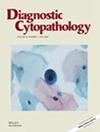Comparative Analysis of Cytologic and Histologic Grading of Malignant Salivary Gland Tumors and Salivary Gland Neoplasms of Uncertain Malignant Potential: A 6-Year Review at a Single Institution
Abstract
Background
The Milan System for Reporting Salivary Gland Cytopathology (MSRSGC) developed and published in 2018 recommends grading salivary gland neoplasms into high-grade (HG) or low-grade (LG), given its impact on clinical management. Although this cytologic grading can be done, in certain cases it can be challenging. Herein we assess the accuracy of cytologic grading of salivary gland neoplasms at our institution.
Method
A retrospective review of medical records identified 365 patients who underwent salivary gland FNA between 2017 and 2022. Cases categorized as malignant, suspicious for malignancy, and salivary gland neoplasms of uncertain malignant potential (SUMP) by the Milan system and with available follow-up histology were selected. FNA cases were reviewed and blindly assigned a cytologic grade. No ancillary testing or cell blocks associated with study cases were examined. The cytologic grade was correlated with the final surgical diagnosis and grade. The diagnostic performance of cytologic tumor grading was determined using histologic grading as the gold standard. One case with intermediate (INT) histologic grade was excluded from this analysis.
Results
Out of 40 cases included in the study, 70% (n = 28) were SUMPs, 5% (n = 2) were suspicious of malignancy, and 25% (n = 10) were malignant. Among the 39 cases analyzed (12 histologic HG, 27 histologic LG), cytologic grading correctly identified 7 of the 12 HG cases, yielding a sensitivity of 58.3% (95% CI: 30.4%–82.5%). Twenty-six of 27 LG cases were accurately categorized as LG on cytology, resulting in a specificity of 96.3% (95% CI: 81.7%–99.8%). The positive predictive value for cytologically diagnosed HG cases was 87.5% (7 of 8; 95% CI: 52.9%–97.8%), and the negative predictive value (LG accuracy) was 83.9%. Overall, cytologic grading demonstrated an accuracy of 84.6% (33 of 39; 95% CI: 69.5%–93.0%). The most common diagnosis among the LG cases accurately graded was acinic cell carcinoma. HG-mucoepidermoid carcinoma (MEC) was the most common diagnosis among HG cases accurately graded. There were seven cases (17.5%) with cytology–histology discordances, four of which involved SUMP tumors that were HG malignancies by histology. Three of the discrepancies involved a histologic diagnosis of adenoid cystic carcinoma.
Conclusion
The study showed an overall high accuracy for cytologic grading of salivary gland neoplasms. Discordance in cytologic grading was more frequent in the SUMP category and involved a histologic diagnosis of HG adenoid cystic carcinoma. Communication with the clinical team should be in place, especially when grading cannot be provided with confidence, and in that situation, suggesting intraoperative consultation for management decisions seems appropriate.

 求助内容:
求助内容: 应助结果提醒方式:
应助结果提醒方式:


